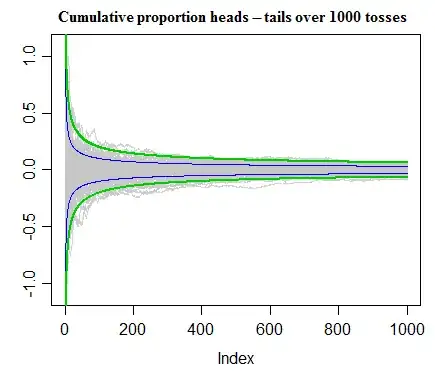they are trying to assert that [...] if there have been 10 heads, then the next in the sequence will more likely be a tail because statistics says it will balance out in the end
There's only a "balancing out" in a very particular sense.
If it's a fair coin, then it's still 50-50 at every toss. The coin cannot know its past. It cannot know there was an excess of heads. It cannot compensate for its past. Ever. it just goes on randomly being heads or tails with constant chance of a head.
If $n_H$ is the number of heads in $n=n_H+n_T$ tosses ($n_T$ is the number of tails), for a fair coin, $n_H/n_T$ will tend to 1, as $n_H+n_T$ goes to infinity .... but $|n_H-n_T|$ doesn't go to 0. In fact, it also goes to infinity!
That is, nothing acts to make them more even. The counts don't tend toward "balancing out". On average, imbalance between the count of heads and tails actually grows!
Here's the result of 100 sets of 1000 tosses, with the grey traces showing the difference in number of head minus number of tails at every step.

The grey traces (representing $n_H-n_T$) are a Bernoulli random walk. If you think of a particle moving up or down the y-axis by a unit step (randomly with equal probability) at each time-step, then the distribution of the position of the particle will 'diffuse' away from 0 over time. It still has 0 expected value, but its expected distance from 0 grows as the square root of the number of time steps. [Note for anyone thinking "is he talking about expected absolute difference or the RMS difference" -- actually either: for large $n$ the first is $\sqrt{2/\pi}\approx$ 80% of the second.]
The blue curve above is at $\pm \sqrt{n}$ and the green curve is at $\pm 2\sqrt{n}$. As you see, the typical distance between total heads and total tails grows. If there was anything acting to 'restore to equality' - to 'make up for' deviations from equality - they wouldn't tend to typically grow further apart like that. (It's not hard to show this algebraically, but I doubt that would convince your friend. The critical part is that the variance of a sum of independent random variables is the sum of the variances $<$see the end of the linked section$>$ -- every time you add another coin flip, you add a constant amount onto the variance of the sum... so variance must grow proportionally with $n$. Consequently the standard deviation increases with $\sqrt{n}$. The constant that gets added to variance at each step in this case happens to be 1, but that's not crucial to the argument.)
Equivalently, $\frac{|n_H-n_T|}{n_H+n_T}$ does go to $0$ as the total tosses goes to infinity, but only because $n_H+n_T$ goes to infinity a lot faster than $|n_H-n_T|$ does.
That means if we divide that cumulative count by $n$ at each step, it curves in -- the typical absolute difference in count is of the order of $\sqrt{n}$, but the typical absolute difference in proportion must then be of the order of $1/\sqrt{n}$.

That's all that's going on. The increasingly-large* random deviations from equality are just "washed out" by the even bigger denominator.
* increasing in typical absolute size
See the little animation in the margin, here
If your friend is unconvinced, toss some coins. Every time you get say three heads in a row, get him or her to nominate a probability for a head on the next toss (that's less than 50%) that he thinks must be fair by his reasoning. Ask for them to give you the corresponding odds (that is, he or she must be willing to pay a bit more than 1:1 if you bet on heads, since they insist that tails is more likely). It's best if it's set up as a lot of bets each for a small amount of money. (Don't be surprised if there's some excuse as to why they can't take up their half of the bet -- but it does at least seem to dramatically reduce the vehemence with which the position is held.)
[However, all this discussion is predicated on the coin being fair. If the coin wasn't fair (50-50), then a different version of the discussion - based around deviations from the expected proportion-difference would be required. Having 10 heads in 10 tosses might make you suspicious of the assumption of p=0.5. A well tossed coin should be close to fair - weighted or not - but in fact still exhibit small but exploitable bias, especially if the person exploiting it is someone like Persi Diaconis. Spun coins on the other hand, may be quite susceptible to bias due to more weight on one face.]

